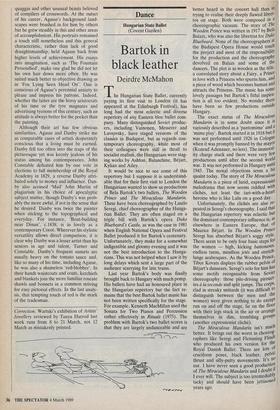Dance
B artok in black leather
Deirdre McMahon
he Hungarian State Ballet, currently
T
paying its first visit to London (it has appeared at the Edinburgh Festival), has long had the most eclectic and diverse repertory of any Eastern bloc ballet com- pany. ,Many. distinguished Soviet produc- ers, including Vainonen, Messerer and LavroVsky, have staged versions of the daisies in Budapest, ry ,but as regards con- temporary choreography, Svhile most of their colleagues ym,re still in thrall to socialist realisni,•the Hungarians were stag- ing works by Ashton, Balanchine, Bejart, Kylian and Ailey. . It would be nice to see some . of this repertory but I sUppose it is understand- able that for their first visit to London the Hungarians wanted to show us productions of Bela Bartok's twb ballets, The Wooden Prince and The Miraculous Mandarin. These .have been choreographed by Laszlo Seregi,. chief choreographer of the Hunga- rian Ballet: They are often staged on a triple . bill with Bartok's opera Duke Bluebeard'S Castle, as was the case in 1981 when English National Opera and Festival Ballet produced it for Bartok's centenary. Unfortunately, they make for a somewhat indigestible and gloomy evening and it was not the best introduction to the Hunga- rians. This was not helped when I saw it by long delays which sent a large part of the audience scurrying for late trains. Last year Bartok's body was finally brought back to Hungary with much pomp. His ballets have had an honoured place in the Hungarian repertory but the fact re- mains that the best.Bartok ballet music has not been written specifically for the stage. FM- example, Kenneth MacMillan used the Sonata for Two Pianos and Percussion rather effectively in Rituals (1975). The problem with Bartok's two ballet scores is that they are largely undanceable and are better heard in the concert hall than in trying to realise their deeply flawed libret- tos on stage. Both were composed in a choreographic vacuum. The story of The Wooden Prince was written in 1917 by Bela Balazs, who, was also the librettist for Duke Bluelieard. None .of the choreographers at the Budapest Opera House would touch the project and most of the responsibility for the production and the choreography devolved on Balazs and some of the dancers. The plot is as wooden as the title, a convoluted story about a Fairy, a Prince in love with a Princess who spurns him, and a piece of wood which becomes human and attracts the Princess. The music has some lovely passages but Bartok's fitful inspira- tion is all too evident. No wonder there have been so few productions outside Hungary. The exact status of The Miraculous Mandarin is in some doubt since it is variously described as. a `pantomime' and a `mime play'. Bartok started it in 1918 but it was not performed until 1926 in Cologne when it was promptly banned by the mayor (Konrad Adenauer, no lesi). The immoral- ity charge stuck and there were ,very few productions until after the second world war. It was not performed in Hungary until 1945. The mdral objections seem a bit quaint today. The story of The Miraculous Mandarin is a piece of lurid, expressionist melodrama that now seems riddled with clichés, not least the tart-with-a-head heroine who is like Lulu on a good day.
Unfortunately, the clichés are also re' peated irt Seregi's choreography. I said that the Hungarian repertory was eclectic but the dominant contemporary influence is, as elsewhere in Eastern Europe, that of Maurice Bejart. In The Wooden Prince Seregi has absorbed Bejart's soggy style. There seem to be only four basic steps for the women — high, kicking banemeres, endless turns, mindless jetes and stretch- lunge arabesques. As the Wooden Prince, Tibor Kovats displays the rubber pelvis of Bej art's danseurs. Seregi's solo for him has some motifs recognisable from Soviet choreography: those pile-driving pirouet' tes u la seconde and split jumps. The corps, clad in streaky unitardS (it was difficult to distinguish between the men and the Women) were given nothing to do except run on and off the stage, lie on the floor with their legs stuck in the air or arrange themselves in dim, trembling groups (another expressionist cliché).
The Miraculous Mandarin isn't mum' better. It brings out the worst in choreog- raphers like Seregi and Flemming Flindt who produced his own version for the Royal Danish Ballet. There are lots of cruciform poseS, black leather, pelvic thrust and silly-putty movements. It's 00 use. I have never seed a good production of The Miraculous Mandarin and I doubt if I ever will. The subject is too irremediably tacky and should have been jettisoned years ago.
At the end of the evening I had no idea what these dancers were like because the choreography did nothing to illuminate them or the company style. There was an odd flash here and there which made me think that the Hungarians are better dan- cers than these two pieces suggest. Perhaps we could have ballets to Liszt or Kodaly next time?

















































 Previous page
Previous page